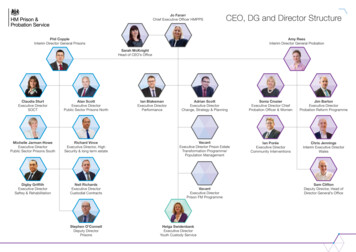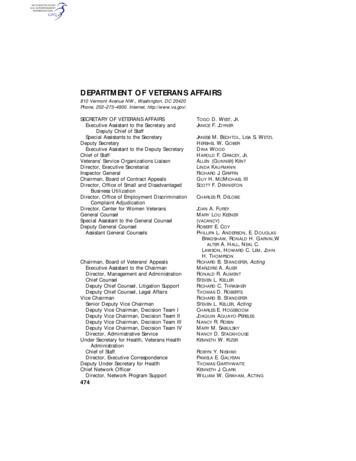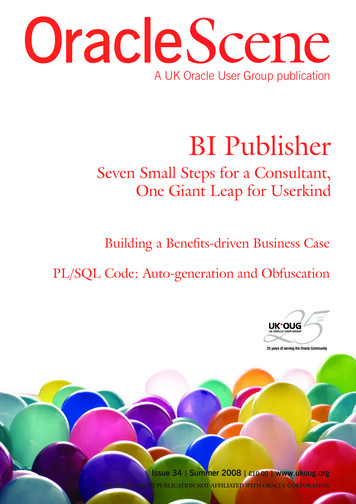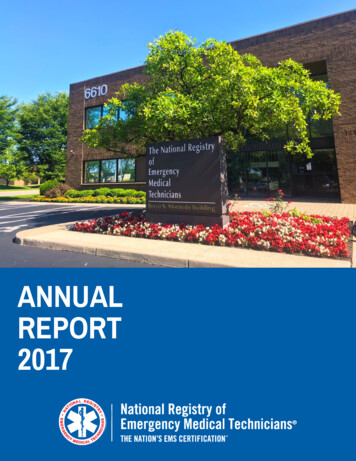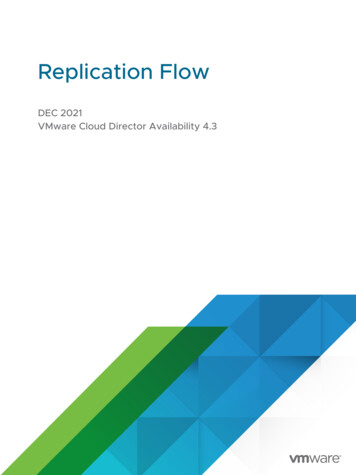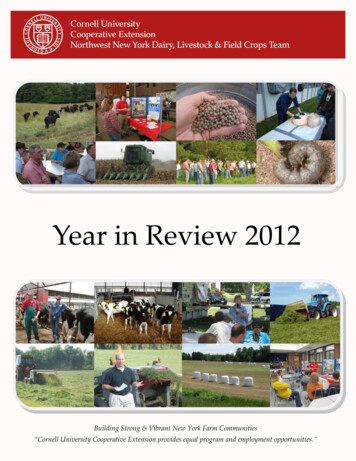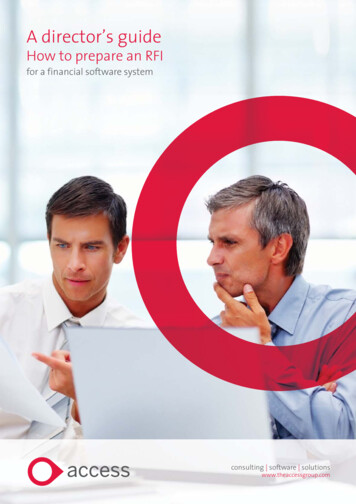
Transcription
A director’s guideHow to prepare an RFIfor a financial software systemconsulting software solutionswww.theaccessgroup.com
Selecting a finance system is a bigdecision, one requiring significantinvestment of time and capital. Youwant to ensure that you choose theright system from the mostexperienced vendor at the best price.Given the average term for a softwaresystem is 7–10 years, this is a longterm commitment so you need to getit right. Costly mistakes can howeverbe avoided by running an effectiveselection process. As with anysuccessful project, preparation is key –and should begin with the process ofdocumenting your needs.need to document your requirementsfor the project in the form of an RFI. Aspart of the RFI creation you will needto consider the selection timeline, andby having a strict timetable, will makesure that you (not the vendors) are incontrol of the process.There are several terms to describethis process. You may be familiar withRequest for Information (RFI), Invite toTender (ITT) or Request for Proposal(RFP). For consistency, we’ll refer to theterm RFI throughout this guide. By theend, you’ll understand exactly how theprocess works, what a good RFI shouldcover, and how you can avoid the mostcommon pitfalls. identification of shortlisted vendorsTo help you get started, we’ve alsoproduced an RFI template. Thisprovides the framework you need tostart completing your RFI. Details ofhow you can download thiscomplimentary document areprovided at the end of this guide.What is an RFI?An RFI is the common way to collectdata on the capabilities of differingsoftware packages and vendors. It is aformal document, detailing yourspecific requirements, aimed to solicitresponses that allow direct comparisonbetween alternative solutions. The RFIwill often be the first point of contactwith a potential supplier, and it sets thetone of the relationship.How does the RFI processwork?Prior to reaching this stage, you willhave identified the need to change,agreed a business case, secured abudget and gained approval to moveto a vendor selection process. Clickhere to read our guide to the selectionand evaluation process. Based on yourspecific needs you have identified alist of potential suppliers, and you now2Any RFI should include specific datesfor: confirmation that the vendor willbe responding submission of questions by vendors completion of responses formal demonstrations byshortlisted vendors selection of the successful vendor contract signing.The remainder of this guide will focuson the RFI document, but carefulconsideration of the selection processis required to ensure you are gearedup to manage the responses.The importance of scopingwithin the RFIIf you were buying a car, you wouldstart with a budget, which would steeryou towards a particular set ofmanufacturers. Then you would focuson the type of car, and then look atspecific features, compare the variousoptions, understand the delivery leadtimes, and then negotiate a price.Setting requirements for a newfinance system should be no different.Here are the key reasons companies sooften get this wrong: the wrong people are involved inthe definition process. Directorsand senior managers can define thebusiness strategy that is driving thechange, but may not be able toarticulate the detailed functionalrequirements. End users may beable to help with the requirementsbut will be focused on their specificpart of the business, and not seethe end-to-end process. So select aproject team which encompassesboth strategic knowledge andoperational detail. difficulty nailing down the specificscope of the project. Scope creep isa classic problem in requirementsdefinition, where stakeholders getcarried away with the possibilitiesof a new system, and continue toadd in new features which mayultimately change the entirecomplexion of the project.Keep revisiting the original projectobjectives and don’t allow excessivescope creep in the RFI. trying to do too much with toolittle. If you are working to a tightbudget, you have to stick to a tightrequirement – don’t be tempted tosqueeze in too much. Somethingwill have to give, and this is usuallythe quality of the deliverable.Think about de-scoping to reducethe budget without constrainingthe solution; choosing a flexiblesystem will ensure you can easilyadd in further functionality whenbudgets allow. being too ambitious with timing.You may have a ‘burning bridge’ interms of a compelling event thatnecessitates change.It may be that you are already toolate based on the work required toeffect the change in time, but don’ttry and rush – either simplify todeliver the bare minimum needednow, or think about contingenciesand set a more sensible date.By keeping the RFI focused on theoriginal project objectives you canensure you don’t end up with a tractorwhen you wanted a family saloon.The RFI formatYour finance system RFI will be unique,based on the specific requirements ofyour business, but they should allcontain the same basic components.The following sections should beconsidered for inclusion in your RFIdocument.Company informationYou need to outline your business, themarket in which it operates, yourproducts and services, and other keyfacts regarding the size and scope ofyour operation. Access 2010. E&OE.
This will provide a useful context forvendors, as well as a guide for theprovision of comparable reference inyour industry.Background & business objectivesThis should detail why your companywishes to implement a new financesystem, or replace an existing system.This is not the place to list all theshortcomings of your currentsoftware. This is about understandingthe key drivers for change – whichcould include enabling growth,increasing efficiency, improvingcompetitiveness, reducing costs orsupporting M&A activity. This will helpvendors to articulate how theirsolution will deliver on your strategicobjectives.Project timescalesThis should include a summary of thekey milestones in the selectionprocess, including an expectation ofproject commencement and go-live.Ensure you include enough time forvendors to respond – a rusheddeadline will result in a poor quality ofresponse, and busy vendors will oftenreject RFIs with unrealistic deadlines.Make sure you give yourself plenty oftime to review responses, and makesure key stakeholders’ diaries areupdated with supplier visit days andRFI response reviews. As a guide, forany significant finance system projectyou will need a minimum six-monthwindow between issuing the RFI andexpected go-live.Format of responseYou need to indicate to the vendorshow you wish the RFI to be completed,including printed copies and electronicdocuments required, and anysupporting information. Insist thatresponses are delivered in your desiredformat, as any vendor-specificresponses will make direct comparisondifficult, and will also make it difficultto understand the extent to which avendor has met your specificrequirements.We’ve provided a template to help youdo just that – see ‘How to use the RFItemplate’ on p5 of this guide. Access 2010. E&OE.Evaluation criteriaVendors need to understand howresponses will be evaluated; the costof the new finance system should notbe the only determining factor. Bysharing your priorities upfront,negotiations can be transparent whilestill getting the best deal for yourcompany. The final selection must bebased on a balanced view of cost,benefit, experience, service standards,functional, technical and cultural fit.You need to give a broad view of yourpriorities so that a vendor candemonstrate their ability to deliveron them.Confidentiality statementThis is to ensure that potentialvendor(s) keep your company and RFIdetails confidential. It is alsoimportant to stress that the answersprovided have contractualsignificance.If your RFI relates to a particularlysensitive business change, or sharesfinancial data, then you may insist ona Non-Disclosure Agreement (NDA)prior to issue of the RFI to the vendor.Vendor queriesExperienced vendors will seek to meetwith you prior to completion of theRFI, in order to clarify requirementsand gain further insight to yourcompany and needs. You maywelcome this as an opportunity togauge interest prior to receipt, and geta feeling for the culture of the vendor.You may also want to share theanswers to any vendor queries with allvendors, to ensure a consistentunderstanding of the requirement.Provide the vendors with someguidance as to the options available.Vendor informationIt is usual to request details on thevendor to understand their suitabilityand security as a partner for what willbe a long-term relationship. Inaddition to financial information suchas recent turnover figures, you mayalso want to understand the companystructure, number of offices, staff ineach department and the proportionof the business dedicated to thesolution proposed.Some vendors will be happy to provideaudited accounts, for others you canrequest the registered companyaddress and the company registrationnumber, and conduct your own creditchecks as part of the due diligenceprocess.Business requirementsThis forms the core deliverable of theRFI, and will be the major focus forvendors. A statement of your businessrequirements should be provided inthe form of a structured checklist,indicating: functional requirements (e.g. abilityto capture and process customerpurchase orders) technical requirements (e.g.solution must be based on aMicrosoft SQL-Server platform) integration requirements (e.g.solution must provide a real-timestock level integration with ourexisting warehouse managementsystem).Vendors should be given theopportunity to state the extent towhich each requirement will be metbased on the solution proposed by thevendor, from ‘standard’ through to‘requiring bespoke modifications’ or‘not achievable’.Special attention should be given tothose requirements which are uniqueto you or your industry, or have provento be a challenge in your currentsolution. Integration with existingsystems should also be carefullyconsidered, as this area is oftenoverlooked.This section of the RFI is best deliveredby the vendor via a spreadsheet tosimplify the generation of a balancedscorecard. The following instructionstake you through this process. This isthe time to sit down and reallythink hard about your business and itsfuture. It is essential to be clear aboutwhat your needs are now and whatthey will be in a few years time.Once complete, the spreadsheetshould be sent to the vendor alongwith your RFI template (to downloadthe template, see p5 of this guide).3
Business requirementsVendor’s response sales & purchase contras1.0FinanceThe ability to analyse revenue bynominal account, revenue type,business unit, sales person andproductCAbility to capture daily andweekly timesheets by resourceand record time against aspecific project or projectsC2.33.7ProjectmanagementNot achievableDescription of requirementBespokeBusiness areaStd with configRef EC-SSD & IntrastatStandardCriticality C/P/O VAT returnsCash management payment authorisationNotes cash flow forecasting bank reconciliation cash collectionProcurement browser-based procurement invoice approval workflowStock &inventorymanagementThe ability to record min/maxPorder levels against a stock itemand automatically highlight whenactual stock exceeds these levelsInterfacesThe solution must ensure thatcustomer records are replicatedacross the new finance systemand the existing web orderingsystem in real time remittance managementSales order management picking & despatch of orders4.15.2TechnicalrequirementsThe core system must operate on Ca Microsoft SQL-Server databaseplatformHow to create the ‘businessrequirements’ document: Create a spreadsheet based on thegrid below (note: the content withinthe chart is for example only). Fill out the second column with thekey operational areas within yourbusiness. We’ve included someexamples – you’ll find many moreunder the next heading. Complete the ‘description ofrequirement’ part of the grid for eachof your business areas – again, usingthe examples below as a guide. Enter the ‘criticality’ for each row inyour chart. As a guide to responses:C – critical, key to the delivery of theoverall solutionP – preferable, while not critical,would be extremely beneficial tothe solutionO – optional, an additionalrequirement that may or may notfeature in the final solution.We have included instructions withinthe RFI template (see p5) to helpvendors respond to your criticalityratings.4CNote: all critical requirements shouldbe met with a ‘standard’ / ‘standardwith configuration’ response.Any responses met with ‘bespoke’ or‘not achievable’ should be questionedfurther as part of the shortlistingprocess to understand the level ofchange required and potential risk tothe implementation.Finally, keep this spreadsheet handyuntil you are ready to send it(alongside your RFI document) to thevendor. customer Invoicing credit control aged debt managementStock & inventory costing & pricing goods receipt & stock movements works orders & bill of materials traceability & stock takes stock forecasting returns managementProject Management project initiation resources planning time capture expense management budgetary controls & milestonesExamples of business areas cost and WIP analysisAs a guide, other functional areas toconsider for a finance system RFImight include: client billingFinancial management standard financial reports core ledgers ad-hoc reporting management accounts budgetingReportingFinance system extensions customer accounts document management &automation supplier accounts KPI dashboards fixed assets integrated payroll multi-currency / multi-language email & Microsoft Office integration Access 2010. E&OE.
web portals data migration alerts user training approach integration API / web services go-live. PDA / Smartphone integration.Solution detailsVendors should provide an overview ofthe software, hardware andinfrastructure components utilised indelivering the proposed financialsolution. This should include productnames, specific modules utilised,integration, methods of user interface,reporting tools and references to anythird-party products utilised.The RFI should state how thisinformation is to be provided by thevendors, and whether additionalinformation such as screen shots orstandard reports are needed.Vendor experienceIdeally vendors will have existingexperience implementing similarsolutions for companies in yourindustry. A minimum of three namedreference sites should be requested,indicating the similarities with yourorganisation and requirements,including specific software used oneach site.You should not expect to be able tospeak to any reference sites as part ofthe RFI process. You should howeverinsist on a reference call or a site visitonce a vendor has been shortlisted.Implementation methodologyVendors should be asked to definetheir implementation methodology,and highlight how it will be used tominimise the risks involved withcomplex systems implementations.You may also request anyaccreditations that this methodologyhas received, or how the consultantsinvolved in the project are accreditedin the methodology.You should request specific details oncertain key elements which should becommon to any implementationmethodology: confirmation of detailedrequirements hardware and software installation software testing process & signoff Access 2010. E&OE.Project planA high level project plan should berequested, indicating expected tasksand timeframes for a project of thisnature. This should correspond to thepricing given, in terms of number ofman days to deliver services, as wellas the stages identified within theimplementation methodology. Theplan will be subject to validation bythe selected vendor, but should give agood indication of the effort requiredto complete.You may also request the amount oftime that you and the majorstakeholders will be expected tocommit to the project, including anyworkshops, testing, training and golive requirements.Go-live planning for the new financesystem will also be key, ensure vendorsidentify the plan for cutover (usuallyafter month end), final transfer of dataetc. and that this fits with youroperational needs.Data migrationSpecial attention should be given to themigration of legacy financial data. Thevolume and type of historic datarequired in the new system will have animpact on costs and implementationtimescales. You will also need toconsider what information will beretained in your old financial system forfuture audit purposes. Provide a highlevel view of what data will bemigrating across, from what systems,and ask vendors to build this into theimplementation plan.Support requirementsYou need to understand the standardservice levels available to you forsupport of the system, includingdetails of where the support team isbased, whether it is outsourced to athird party, support response times,and what is included and excluded inthe support fee. You also need tounderstand the escalation processshould a support requirement not bemet, including the process to addressany software faults found in your livesystem. If you have special supportrequirements (e.g. outside of normalworking hours) you need to indicatethis to the vendor in the RFI.CostsYou need to split out different costtypes for comparability purposes. Askfor the costs to be presented in aspecific format, again for comparability.You therefore need to request thefollowing: the type of cost quoted for theproject (e.g. fixed price, time &materials) upfront costs such as software anduser licenses, implementationservices, and consultant day rates transactional costs (for SaaS typearrangements) ongoing costs such as support,upgrade and general maintenance any additional costs such as projectmanagement, or project contingency timing of payments (payments atcontract signing, on installation, ongo-live etc.)User numbers will have an impact oncosts, so you will need to state thenumber of users by function / role: core finance users – generallyworking in the finance function andusing the system on a daily basise.g. purchase invoice entry managers – may need access to thefinance system for the purposes ofreporting or approving invoices other users – dependent on scopeof the system, some users mayneed to interact with the financesystem to enter personaltransactions such as timesheets orexpense claims.If finance is required to fund the project,you may want to request the fundingoptions available from the vendor.It should be stated that all costsrelating to the preparation,submission, and presentation of thesupplier’s response to this RFI shouldbe borne by the supplier.How to use the RFI templateWe’ve made an RFI template available atwww.theaccessgroup.com/RFI-financecovering the most commonrequirements as detailed in this paper.5
We recommend the following steps incompletion of the RFI template: meet with the major stakeholdersto confirm the objective of theproject, the high level scope, keydates and the evaluation criteria tobe used meet with the functional owners todetail the functional requirements,user numbers, transactionalvolumes, data migrationrequirements and support needs meet with your IT department orprovider to document the technicaland interfacing requirements, andwhat IT support will available formigration, testing andimplementation develop a draft of both the RFI andbusiness requirements documentsfor internal circulation and ensureall parties sign off the detail priorto issue once both documents are signedoff, contact the selected vendors toconfirm to whom you should emailthem to. Make sure to requestformal confirmation that thevendor is willing to engage withyou in the selection process.Who we areFurther informationAccess will give you the advice, toolsand clarity you need to make effectivedecisions, quickly and with certainty.As both a business-focusedconsultancy and a specialist softwaredeveloper, we combine our innovativesoftware with practical experience todeliver a solution that’s exactly rightfor you and your business.For further information on Accesssolutions, please telephone us on0845 345 3300, emailinfo@theaccessgroup.com or,alternatively, visit our website atwww.theaccessgroup.com. You canalso follow us on Twitter atwww.twitter.com/theaccessgroupYou can rely on us to provide you witha solution that’s simple, proven andrelevant to your company. We haveover 15 years’ experience of developingsoftware here in the UK and ourregional consultants have tailored andimplemented this software all overthe UK and in Ireland. The expertisewe’ve gained gives us an unbeatableability to accurately assess your needsand deliver maximum impact withease and confidence.We believe your solution must be readyfor the future, as well as right for today.Because your business will constantlyevolve, we provide a software solutionthat grows with you. Our modularsoftware covers a complete range ofbusiness, financial and administrationprocesses and can be flexed to give youthe precise view of your business thatyou need at any time.SummaryA structured approach to the RFI willensure you make a truly informeddecision, and reduce the amount oftime wasted investigatinginappropriate finance solutions andpartners. The RFI process need not be adaunting one if approachedmethodically, and the up-frontinvestment of your time will ensure youget the solution that is right for you.Our supportive consultants combinetheir first-class software expertisewith in-depth industry knowledge toconstantly improve and simplify yourbusiness processes so that yoursolution delivers maximum value anda continual return on investment.With Access, you can be sure you’vegot the clarity you need to reach yourbusiness goals.consulting software solutionswww.theaccessgroup.com
produced an RFI template. This provides the framework you need to start completing your RFI. Details of how you can download this complimentary document are provided at the end of this guide. What is an RFI? An RFI is the common way to collect data on the capabilities of differing software packages and vendors. It is a formal document .
